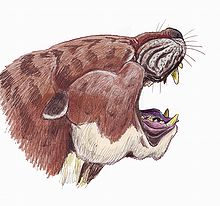Sarkastodon
| Sarkastodon Temporal range: early to late Eocene
| |
|---|---|

| |
| Reconstruction of Sarkastodon mongoliensis | |

| |
| Skull reconstructions of Sarkastodon mongolensis | |
| Scientific classification | |
| Domain: | Eukaryota |
| Kingdom: | Animalia |
| Phylum: | Chordata |
| Class: | Mammalia |
| Order: | †Oxyaenodonta |
| Family: | †Oxyaenidae |
| Subfamily: | †Oxyaeninae |
| Genus: | †Sarkastodon Granger, 1938[1] |
| Type species | |
| †Sarkastodon mongoliensis Granger, 1938
| |
| Species | |
Sarkastodon ("meaty tooth") is an extinct genus of mammal within the creodont family Oxyaenidae that lived during the early to late Eocene, 48.6 to 37.2 million years ago. It was a large, carnivorous animal that lived in what is today China and Mongolia.[1] Sarkastodon is known only from a skull and jawbones. Sarkastodon was probably a hypercarnivore that preyed on large mammals in its range during the Late Eocene, such as brontotheres, chalicotheres, and rhinoceroses. Its weight is estimated at 800 kg (1,800 lb),[3] and its length at 3 m (10 ft).[4]
Discovery
The type specimens of S. mongoliensis are known from Eocene deposits from the Irdin Manha Formation of Mongolia. Additional material referred to Sarkastodon is known from the Ulan Shireb beds (160 kilometres or 100 miles from the holotype locality) of Inner Mongolia. These specimens were discovered by Walter W. Granger in 1930, on an expedition to the Gobi Desert.[1]
Palaeobiology
Sarkastodon was a hypercarnivore, with hyaena-like dentition specialised in bone-cracking.[5][6] The sharp, slicing premolars (which form roughly rectilinear cutting blades)[7] and crushing molars enabled Sarkastodon to eat both bone and flesh.[8] It was probably an ambush predator, not a fast runner.[4]
Phylogeny
The phylogenetic relationships of genus Sarkastodon are shown in the following cladogram.[9][10][11][12]
| Pan-Carnivora |
|
†Altacreodus/Tinerhodon clade | |||||||||||||||||||||||||||||||||||||||||||||||||||||||||||||||||||||
References
- ^ a b c d Granger, W. (1938.) "A giant oxyaenid from the upper Eocene of Mongolia." American Museum Novitates 969.
- ^ Y. Tong and Y. Lei. (1986.) "Fossil Creodonts and Carnivores (Mammalia) from the Hetaoyuan Eocene of Henan." Vertebrata PalAsiatica 24(3):210-221
- ^ Sorkin, B. (2008). "A biomechanical constraint on body mass in terrestrial mammalian predators". Lethaia. 41 (4): 333–347. doi:10.1111/j.1502-3931.2007.00091.x.
- ^ a b Prothero, Donald R. (2016). The Princeton Field Guide to Prehistoric Mammals. Princeton University Press. p. 125. ISBN 9781400884452.
- ^ Rose KD. (2006.) The Beginning of the Age of Mammals. JHU Press: page 122
- ^ Werdelin, L. (1989). "Constraints and adaptations in the bone-cracking canid Osteoborus (Mammalia: Canidae)". Paleobiology. 15 (4): 387–401. doi:10.1017/S009483730000957X.
- ^ Muizon, C. de; Lange-Badré, B. (2007). "Carnivorous dental adaptations in tribosphenic mammals and phylogenetic reconstruction". Lethaia. 30 (4): 353–366. doi:10.1111/j.1502-3931.1997.tb00481.x.
- ^ Gunnell, GF. (1998.) "Creodonta", p. 91-109. In: Janis CM., Scott K.M., and Jacobs LL. (eds.). Evolution of Tertiary Mammals of North America, Volume 1: Terrestrial Carnivores, Ungulates, and Ungulatelike Mammals. Cambridge University Press, Cambridge.
- ^ Gunnel, Gregg F.; Gingerich, Philip D. (1991). "Systematics and evolution of late Paleocene and early Eocene Oxyaenidae (Mammalia, Creodonta) in the Clarks Fork Basin, Wyoming" (PDF). Contributions from the Museum of Paleontology. 28 (7). The University of Michigan: 141–180.
- ^ Solé, F. & Ladevèze, S. (2017.) "Evolution of the hypercarnivorous dentition in mammals (Metatheria, Eutheria) and its bearing on the development of tribosphenic molars." Evolution & Development, 19(2), 56–68.
- ^ Prevosti, F. J. & Forasiepi, A. M. (2018.) "Introduction. Evolution of South American Mammalian Predators During the Cenozoic: Paleobiogeographic and Paleoenvironmental Contingencies"
- ^ Shawn P. Zack (2019). "A skeleton of a Uintan machaeroidine 'creodont' and the phylogeny of carnivorous eutherian mammals". Journal of Systematic Palaeontology. 17 (8): 653–689. doi:10.1080/14772019.2018.1466374. S2CID 89934728.
External links
- Artistic reconstruction of Sarkastodon, shown waiting for Andrewsarchus to finish eating from a dead brontothere.
